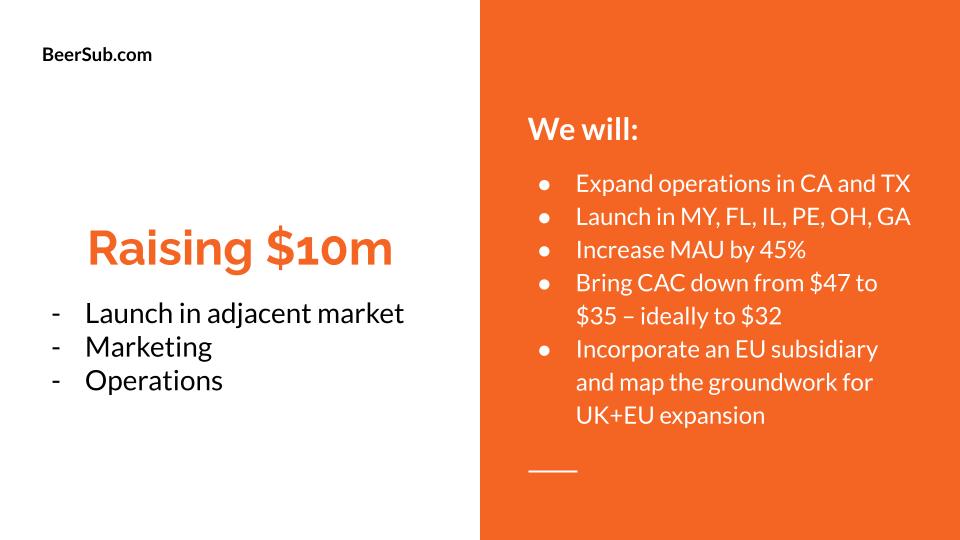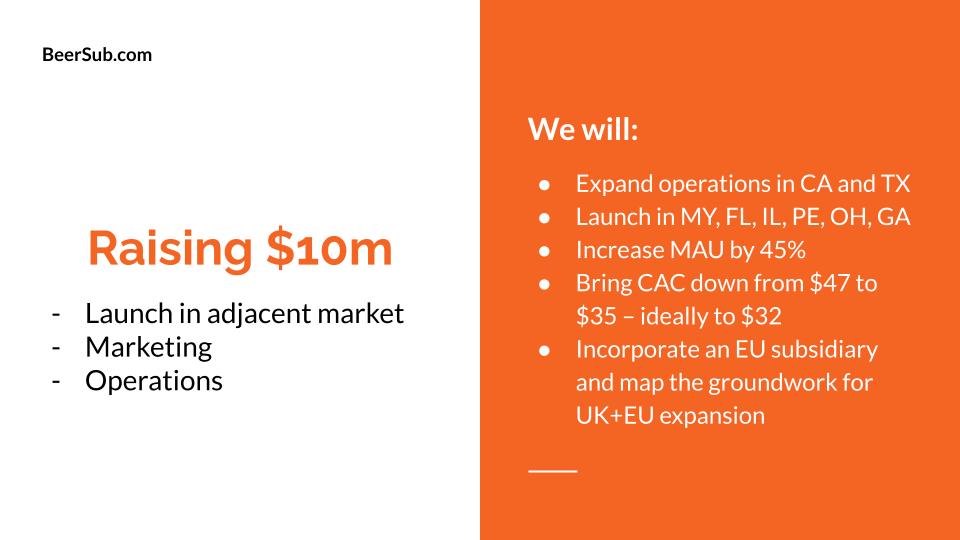You’ve brushed off your Keynote skills, you’re giddy that you’re finally going to be able to start paying yourself a living wage, and you are excited to start pitching your startup’s next round of funding to your investors. It’s heady times, for sure, but hit the other pedal there for a moment, friend — you may be forgetting something.
After working with hundreds of founders on raising money — including the fantastically popular Pitch Deck Teardown series here on TechCrunch+ — there’s one slide that almost every founder gets woefully wrong. The slide is often referred to as The Ask. Or, as one investor friend calls it, the “what is my $10 million going to buy me”? slide.
TechCrunch+ is having an Independence Day sale! Save 50% on an annual subscription here. (More on TechCrunch+ here if you need it!)
The Ask is a sensitive topic to a lot of inexperienced entrepreneurs, which makes sense. Trying to right-size a funding round can be a little overwhelming, and there are a thousand different ways of building a startup. If you were successful in raising $8 million, you can do things one way. If you raised $12 million, you could perhaps launch more features of your product a little faster, or experiment more, or go after an additional market earlier. You know that. Your senior staff knows that. Your investors know that. But regardless, you need a Plan A.
What do you need to do?
A lot of founders will tell you that they are trying to raise enough money to survive for the next 18 months. That’s probably true, but that will be true regardless of how much money you raise. A better approach is to think about what you need to accomplish to raise your next round of funding, and then work backward from there. This is probably a combination of metrics and milestones.
Metrics are the measurable parts of your business that grow and evolve over time. One of the best metrics you have is revenue, but there could be many others: the number of sales, average order value (AOV), monthly or annual recurring revenue (MRR or ARR, respectively), customer acquisition cost (CAC), customer lifetime value (LTV), daily and monthly active users (DAU and MAU), retention rate (usually expressed by its inverse, churn rate) and much more. What do those key metrics need to look like in order to raise not this round of funding, but your next one?
Milestones are also measurable parts of the business, but instead of tracking them over time, they tend to be binary: You’ve either hit a milestone or you haven’t. For startups, this could be key hires; finding the perfect, experienced CFO that can help take your company public is one major milestone a lot of companies at some point need to hit. Product launches (coming out of beta), launches in particular markets (launching only in California) and localization (launching your app in Spanish and French, for example) are also important milestones. Financial milestones are also common; the first time you make a single dollar from any customer is a huge shift in the business. When a customer, on average, starts to make you more money than it costs you to acquire them is another. For earlier-stage companies, completing a customer validation phase by talking to, say, 100 potential customers is a milestone.
When you’re raising money, you will be mapping out a set of milestones that you need to hit in order to validate your company. In addition, you’ll set a number of trigger points for metrics — hitting $1 million ARR, having 5,000 daily active users or finding a combination of customer acquisition channels that means you can acquire customers at a reasonable blended CAC, for example.
So let’s examine how to put together a great “ask” slide by ascertaining what it takes to determine how much you need to raise, how to create a specific set of goals and how to bring it all together in a coherent whole.
How much is it going to cost?
Once you have a set of milestones and metrics — the things you need to accomplish — you need to model what it’ll take to hit those goals. This goes into a modeling spreadsheet, where you can attach costs to each of these things; what resources do you need, in terms of equipment, tools, platforms, staff (operational and engineering), etc.? Figure out both how long it takes and how much it will cost, and you have a time-and-money model for what you need to do.
If you end up with an astronomically high number compared to the stage of your company, this should probably trigger some replanning. For example, if you are a brand new SaaS startup with two founders, no staff, little in the way of product and no customers, and your model shows that you are going to need $30 million in order to hit the metrics and milestones you’ve chosen, you probably need some stepping stones along the way. In that scenario, it’s more realistic to raise $2 million, so the question becomes what interim milestones can you hit to prove that your company deserves to exist. In the early days, you probably need to build out some MVPs that can help validate your value proposition.
Assuming that the number you need to raise is within the realm of reasonable, pad it with 30% or so (you may as well — no plan ever survives contact with the enemy, so give yourself a bit of grace), and that’s the fundraising goal you’re aiming for. Congratulations — the “ask” slide is now half done.
What are you going to accomplish?
One half of the “ask” slide is how much you are raising. The other half is what you’re going to do with the money. I’ve seen some truly awful slides that just list “40% engineering costs, 30% operations costs, 30% marketing” without further explication. That’s better than not saying anything about how the funds are going to be used, but it doesn’t actually explain how the funds will be invested to progress your company.
I’ve seen some worse slides that say “With $2 million we will have an 18-month runway.” That’s nice for you, but it doesn’t help your investors decide whether they are making a sensible investment. Nobody cares if your company will stay alive for 17 to 19 months; they will care whether you’re able to make meaningful progress toward an ultimate goal. For startups, that means an acquisition or an IPO — everything else is window dressing. Merely staying alive is an accomplishment, don’t get me wrong, it just doesn’t meaningfully improve your odds of doing well.
A far better approach is to actually surface those metrics and milestones you’ve been sweating over.
Be specific
If it’s scary to name a specific amount of money you’re raising, it’s doubly scary to make predictions for what you’re going to deliver to your investors (in terms of progress in your company) with the cash. Guess what — if you’re not ready to be in a state of permanent terror, you’ve picked the wrong profession, so let’s get in there and make some predictions. The good news is that these “predictions” are already in your model and your operating plan, so all you have to do is to repeat the plans you already have.
When I’m encouraging specificity, I’m encouraging you to set smarter goals. SMART goals, to be precise; goals that are specific, measurable, achievable, relevant and time bound. The first two mean that your goals are clearly defined and that you can easily tell whether you’ve hit a goal. For example, “$1 million ARR,” is measurable, and as long as you have a clear picture of how to measure ARR for your business, it’s specific as well. The relevance is there; if you hit that magical $1 million ARR, you’ll make it significantly easier to raise your next round of funding. If it’s achievable — i.e., you and your team truly believe that if things go to plan, you’ll hit $1 million of annual recurring revenue — that puts you on the right track. And finally, your deadline is pretty clear; you need to hit that goal before the money runs out but ideally a little bit before things get overly dicey.
The more specific your goals are, the easier it is to know whether you’re trending toward them. Personally, I’d share the goals with the entire company and encourage everyone to take shared responsibility for working toward them.
Putting it all together
Let’s take another look at the sample slide I threw together for BeerSub.com, the fictional company I created for the book I wrote about pitching :

The “raising $10 million” part of this slide is clear, and the list underneath is … not great, because it isn’t specific. On the right-hand side, though, things are a little better.
“Expand operations in California and Texas,” is not a SMART goal; it isn’t measurable. In theory, if you hire one new customer service person in each of those states, you’ve ticked the boxes, and it’s unclear whether that helps you raise the next round of funding. This part of the slide only works if there’s a more detailed plan elsewhere in the deck about what “expanding operations entails.”
The rest of the slide is good, though: Launching is a binary action; you’ve either launched or not. Even better would be to set individual per-state goals for customer acquisition. Increasing the monthly active users by 45% is measurable and good. Reducing CAC is clear, and incorporating a subsidiary is binary, so it’s easy to know whether that’s been successful. I’d love to have seen more specific data for what “mapping the groundwork” does, but taking on a whole new continent is probably outside the scope of a single bullet point on a pitch deck. This founder had better have a slide explaining the strategic importance of the EU market, how they would measure success and how they’d make a go/no-go decision.
Why is this so important?
Investors see hundreds, if not thousands, of investment decks. They are trying to figure out not just whether you are a good investment, but whether you are a good bet compared to the other hundreds of opportunities they see every week. Decisions as to whether to explore your company further can often turn into a simple question: Is this a believable founder? Do I, the investor, believe that this founder has what it takes to lead their team through this gauntlet and make it out the other side?
Having a clearly formulated, well-thought-through, believable plan goes a long way toward reassuring someone that you’re a solid bet. Having a great “ask” slide can help reassure investors: It shows a founder wants to raise an amount of money that unlocks the next stage of growth and knows what milestones they need to hit to get there. It helps make your pitch stand out from the vast majority of other founders out there raising money.































Comment